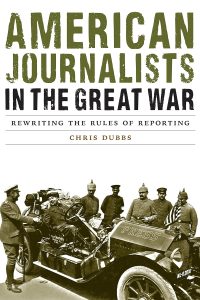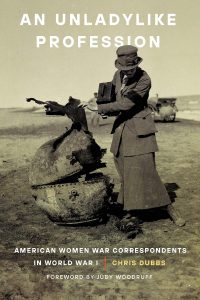American Journalists and the Great War
One of the challenges of writing history is deciding where the story starts. For me that not only means deciding where I begin telling the story, but how much of the backstory I need to understand. The short answer is, a lot. I am never comfortable making broad generalizations based on other people’s broad generalizations.
For The Dragon From Chicago, I spent a lot of time learning about the history of foreign and war correspondents. It had not dawned on me before I began working that overseas press bureaus as we know them were, like so much of life in the mid-twentieth century, an outcome of World War I. If I was going to understand the conditions under which Sigrid Schultz worked, I needed to understand how journalists covered the Great War.
I started with very general books on the subject, most notably Philip Knightley’s the First Casualty: The War Correspondent as Hero and Myth Maker from the Crimea to Iraq.* Knightley’s book is a solid, accessible introduction to the subject. If I were a different kind of writer I could have stopped there.
I’m so glad I didn’t. If I had, I might not have discovered Chris Dubb’s two excellent books on American journalists in the Great War.
American Journalists in the Great War: Rewriting the Rules of Reporting (2017) is a deep dive into the experience of American journalists who reported on the war in Europe in which Dubbs argues that they redefined war coverage. (For what it’s worth, I agree.) He looks at the journalists who covered both fronts before America entered the war in April 1917, including those who attached themselves to the German army. He outlines the development of an accredited news force attached to the American Expeditionary Force (A.E.F.), in greater depth than Knightley. He follows the experiences of individual journalists, in the Balkans, in Russia, in the trenches of the Western front. My only quibble with the book is a personal one: only two of the World War I correspondents who later reported from Berlin made an appearance. I would have loved to see them through another historian’s eyes.
Dubbs briefly discussed women who managed to report on the war in American Journalists in the Great War. He covered the subject in greater depth in a second book, An Unladylike Profession: American Women War Correspondents in World War I (2020). Women weren’t allowed to become accredited war correspondents attached to the AEF, but some gained credentials as “visiting correspondents” for magazines and others made their way to Europe with no credentials at all. Dubbs covers the stories of more than thirty women who reported on the war. Their shared assignment was to cover the “woman’s angle” of the war. As a group they stretched that definition to include much more than their editors intended. (My personal favorite, mystery novelist Mary Roberts Rinehart, was the first journalist to visit the front line trenches.) An Unladylike Profession was less useful to me than his more general book, but I found it absolutely fascinating, for obvious reasons.
I give both books a big thumbs up for anyone interested in the history of journalism, the First World War, or kick-ass women.
* “The first casualty when war comes, is truth.” Senator Hiram Johnson. 1917. (In case it isn’t obvious from that quotation, Johnson was not a fan of the United States getting involved in the Great War. He was also a major player in the United States’ decision not to sign the Versailles Treaty and a leader of the isolationist movement in the period leading up to the Second World War, though he hated being referred to as an isolationist.)







Thanks.
always glad to share a good book with my readers